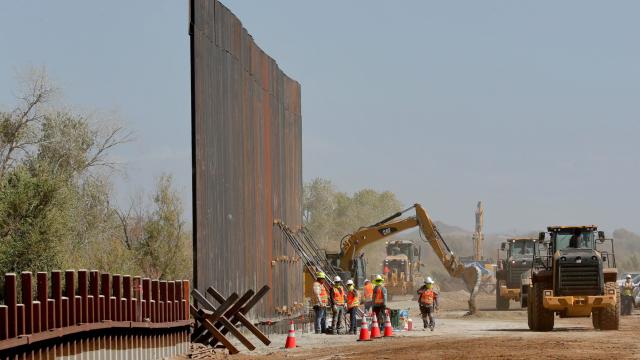We really don’t need another reason to hate U.S. President Donald Trump’s stupid border wall, but here’s a new one anyways. Documents the U.S. Centre for Biological Diversity obtained from the Fish and Wildlife Service through public records requests reveal how the border wall construction is harming critical habitat for eight endangered species at Arizona’s San Bernardino National Wildlife Refuge.
Shared with Gizmodo on Tuesday, the emails show FWS staff raising concerns over the damage border wall construction is having on the refuge. In an email dated December 20, 2019, refuge manager Bill Radke wrote to his colleagues, “Region 2 considers the ongoing water withdrawal adjacent to [the refuge] as being the current greatest threat to endangered species in the southwest [sic] region.” His words, not mine: “the current greatest threat to endangered species in the southwest region.” This is a big motherfucking deal, y’all.
“This administration’s cruelty knows no bounds,” said Laiken Jordahl, a borderlands campaigner with the Centre for Biological Diversity. “In terms of the urgency that you see in those emails, that goes to show that we’ve got all these agency scientists and professionals who have been doing everything they can to sound the alarm, but they have been ignored, stonewalled, and just cut out of the process.”
In the five documents CBD shared with Gizmodo, it was clear that FWS staff were against the destruction happening on the refuge. It was also clear that they were powerless to do anything about it. Trump made the U.S.-Mexico border wall his his big campaign promise to attract hateful, racist voters, and he has followed through on building portions of it as president. He wants to keep immigrants out, no matter the cost. The costs are plenty, of course, especially when you factor in the impact of demonising living, breathing people who attempt to cross the border every day in search of a better life and safety.
But the wall has also been an ecological disaster. The U.S. Department of Homeland Security waived environmental review laws, making it easier for the project to result in the contamination and destruction of essential ecosystems.
The segment that runs through the San Bernardino Wildlife Refuge is 32 km long, and requires massive amounts of water for the cement to lock it in place. Construction crews are pumping 2,649,787 l of water out a day of the San Bernardino Valley, which feeds into the refuge and supplies wells, ponds, and other wetlands. This water withdrawal for the border wall has left some ponds dry and forced FWS staff to “salvag[e] fish,” as Radke wrote in a December 11, 2019, email to his team.
“We are monitoring pond levels,” Radke wrote. “We are developing/implementing contingency plans to protect at least a subset of the endangered fish population that once thrived on the refuge. We are hoping for the best, but are planning for the worst.”
The refuge is home to a number of endangered species, many of which are fish. All of these creatures need water, the most precious resource in the desert, to survive. FWS staff have installed water monitoring systems throughout the refuge to keep track of water levels. But for now, it’s being diverted to create cement and for dust control.
“We’re talking about the most valuable natural resource in the desert just being pissed away to suppress dust for construction activity,” Jordahl said. “That shouldn’t be happening in the first place”¨.”
It’s not just San Bernardino’s resources that are under assault either. Scientists have warned of irreparable harm to animals that frequently cross the U.S.-Mexico border, including desert big cats that need space to roam freely. All told, at least 100 endangered species are threatened by the wall.
The impacts are already being felt in places like Organ Pipe National Monument in Arizona, which the administration has been blasting through. Among other impacts, construction crews there have destroyed iconic saguaro cacti. These lands are also sacred to the Tohono O’odham Nation yet the wall threatens at least 22 culturally significant sites.
In Southern California, members of the Kumeyaay Nation have also protested the border wall, blocking construction vehicles with their bodies. Just last month, a water truck went as far as to spray these land defenders.
“As more miles of wall go up, we’re seeing new sacred sites be destroyed,” Jordahl said. “We’re seeing life-saving springs be drained and just complete disregard for border communities, for sovereign tribal sovereignty nations, and for conservationists who continue to sound the alarm about all of the costs of border wall construction. I think this information, while it specifically pertains to the San Bernardino Refuge, this is the exact same pattern we’re seeing all across the border.”
